Abstract
Cationic manganese-porphyrin complexes, free or targetted with an intercalating agent, are able to cleave DNA using oxygen atom donors like potassium monopersulfate or magnesium monoperphthalate as coreactants. Detailed studies of the cleavage of calf thymus DNA, before and after a heating step, show that free bases and 5-methylene-2-furanone are the main reaction products, indicating that hydroxylation at the 1'-carbon atom is the main target of these chemical agents. These data confirm that metalloporphyrin derivatives interact with the minor groove of double-stranded DNA. Hydroxylation of one of the two C-H bonds at position-5' is another initial DNA damage, characterized by the formation of furfural as sugar degradation product. Besides these two main initial damage sites, a low contribution of a hydroxylation reaction at C4' can not be definitively discounted, while an hydroperoxidation route at C4' can be excluded.
Full text
PDF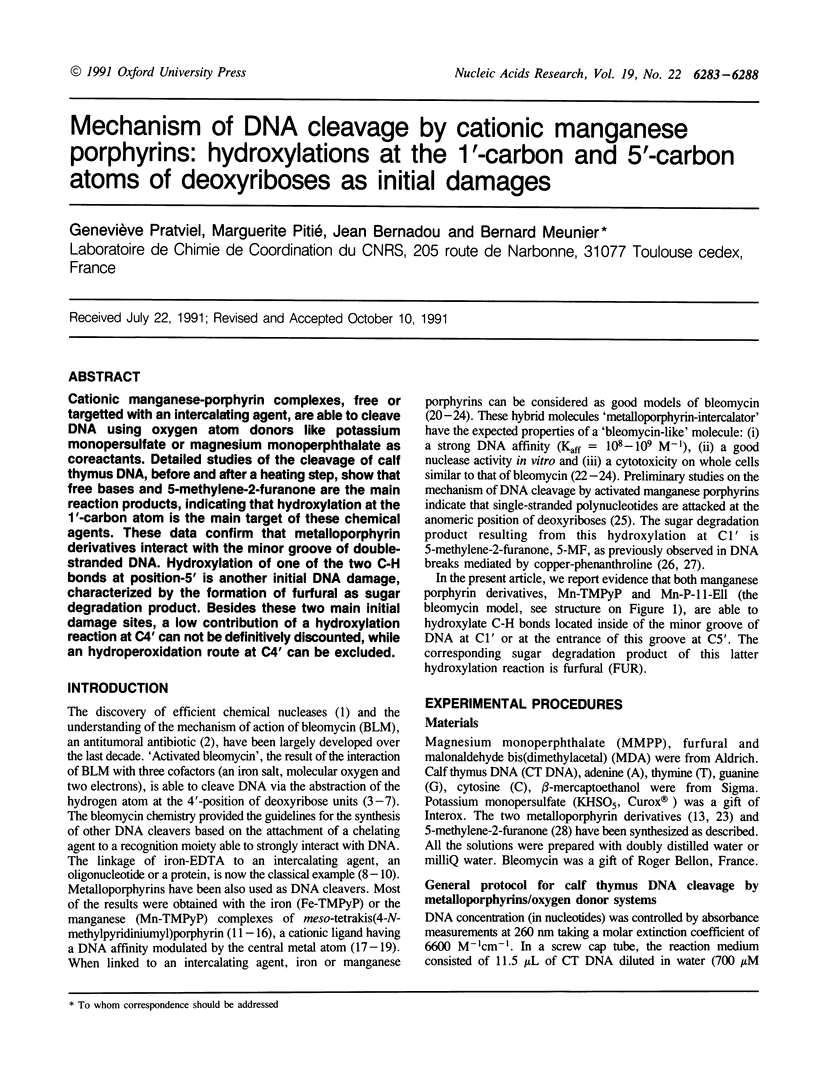
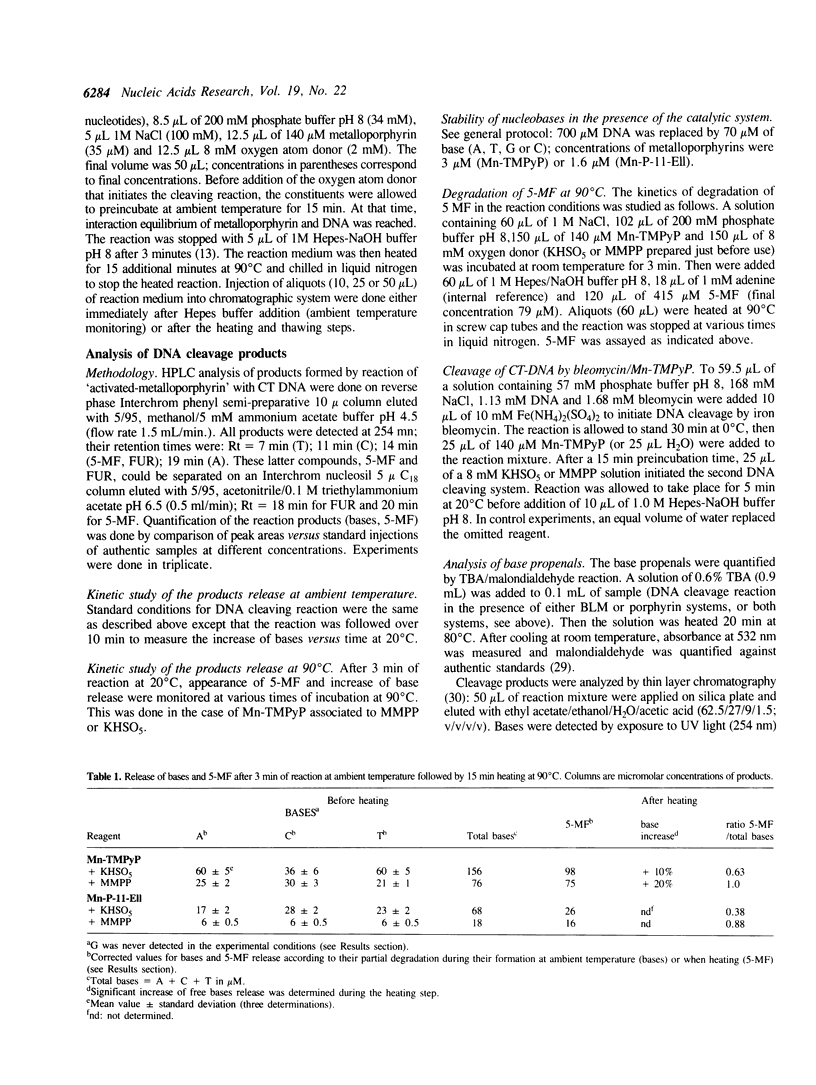
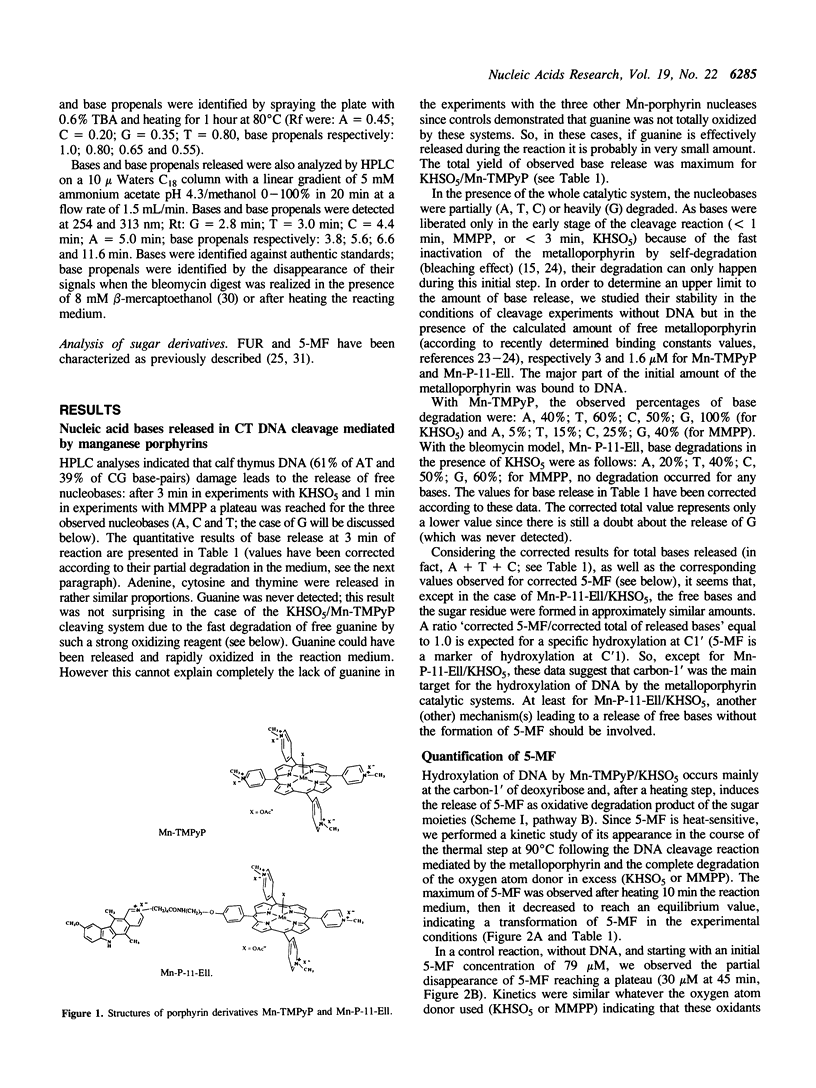
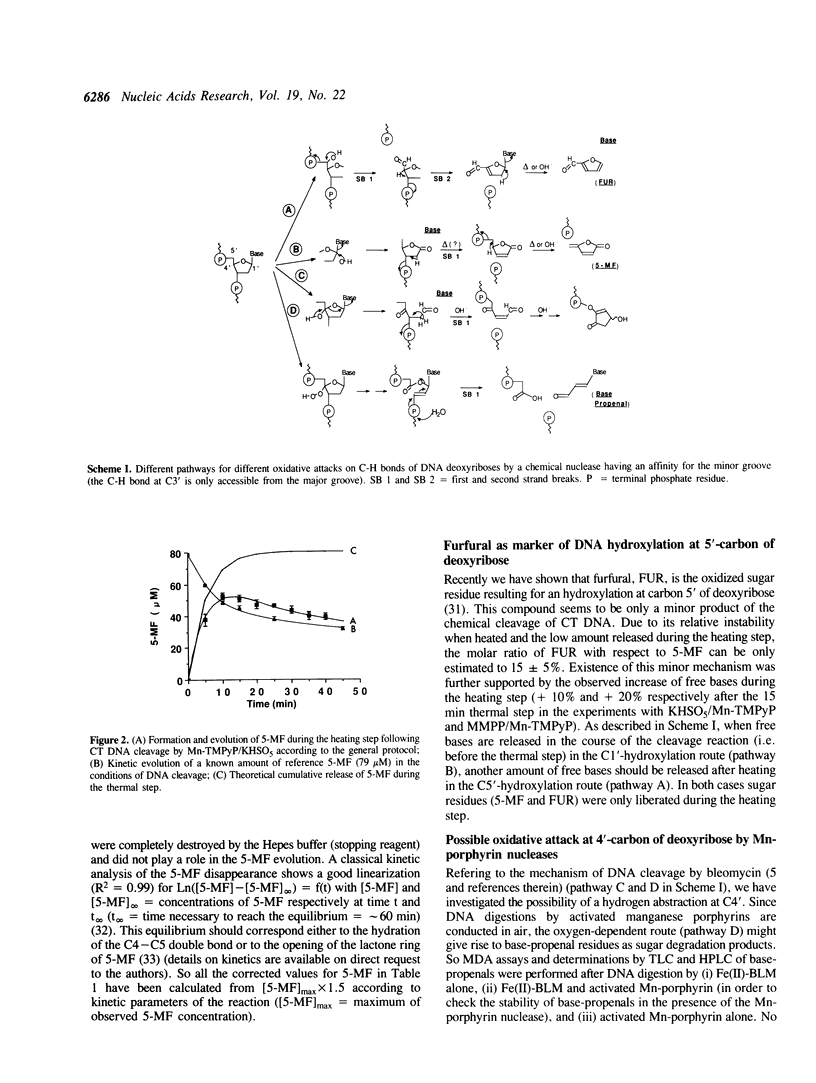
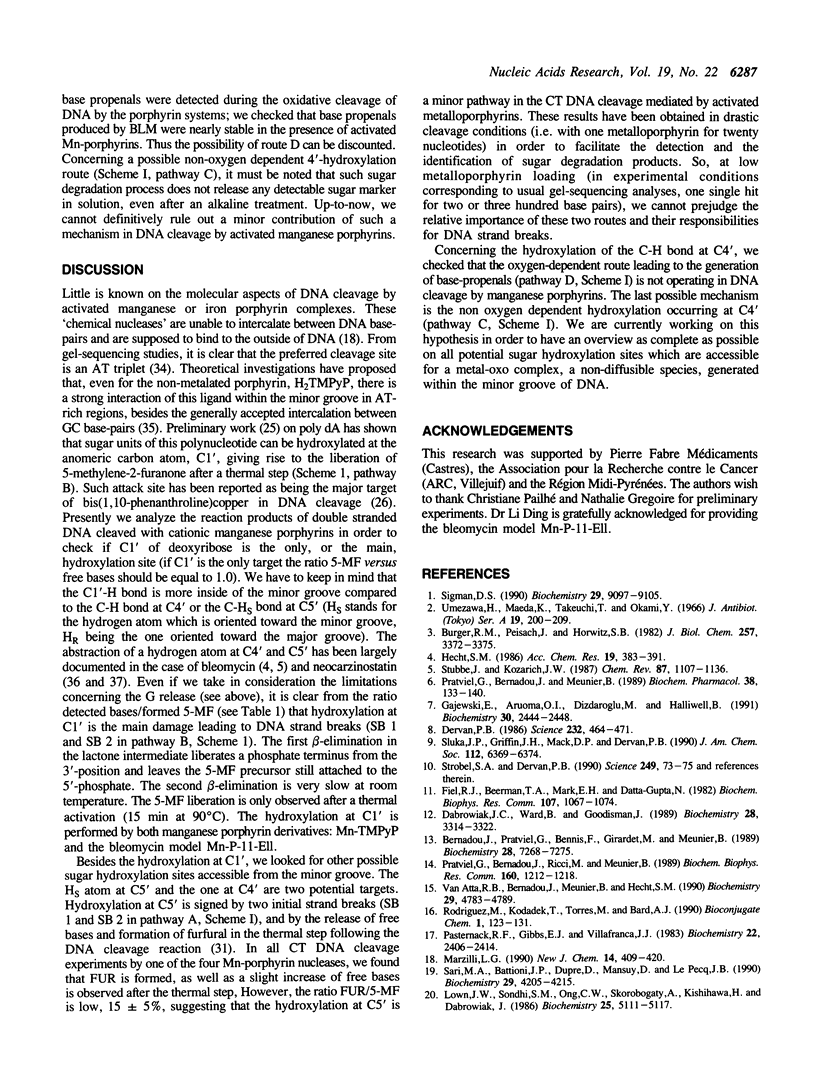
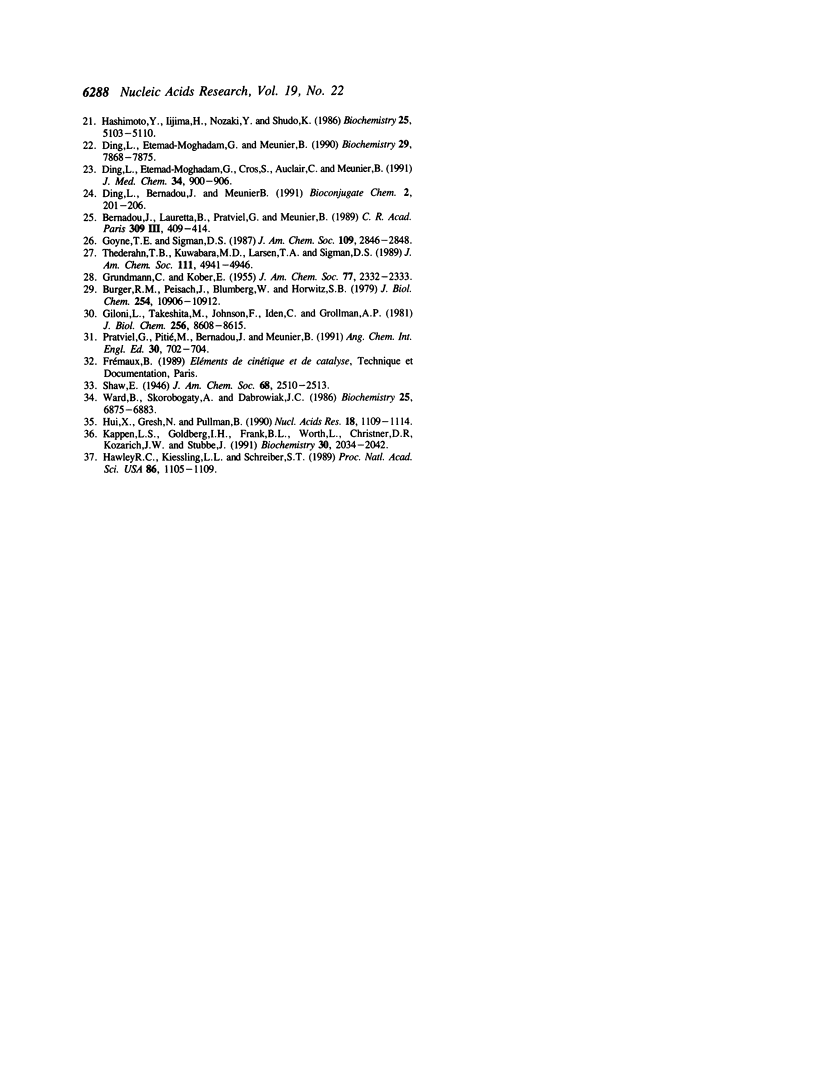
Selected References
These references are in PubMed. This may not be the complete list of references from this article.
- Bernadou J., Lauretta B., Pratviel G., Meunier B. Sur l'hydroxylation du carbone-1' du déoxyribose comme mécanisme de coupure du poly(dA) par une porphyrine de manganèse associée au monopersulfate de potassium. C R Acad Sci III. 1989;309(10):409–414. [PubMed] [Google Scholar]
- Bernadou J., Pratviel G., Bennis F., Girardet M., Meunier B. Potassium monopersulfate and a water-soluble manganese porphyrin complex, [Mn(TMPyP)](OAc)5, as an efficient reagent for the oxidative cleavage of DNA. Biochemistry. 1989 Sep 5;28(18):7268–7275. doi: 10.1021/bi00444a019. [DOI] [PubMed] [Google Scholar]
- Burger R. M., Peisach J., Blumberg W. E., Horwitz S. B. Iron-bleomycin interactions with oxygen and oxygen analogues. Effects on spectra and drug activity. J Biol Chem. 1979 Nov 10;254(21):10906–10912. [PubMed] [Google Scholar]
- Burger R. M., Peisach J., Horwitz S. B. Effects of O2 on the reactions of activated bleomycin. J Biol Chem. 1982 Apr 10;257(7):3372–3375. [PubMed] [Google Scholar]
- Dabrowiak J. C., Ward B., Goodisman J. Quantitative footprinting analysis using a DNA-cleaving metalloporphyrin complex. Biochemistry. 1989 Apr 18;28(8):3314–3322. doi: 10.1021/bi00434a029. [DOI] [PubMed] [Google Scholar]
- Dervan P. B. Design of sequence-specific DNA-binding molecules. Science. 1986 Apr 25;232(4749):464–471. doi: 10.1126/science.2421408. [DOI] [PubMed] [Google Scholar]
- Ding L., Bernadou J., Meunier B. Oxidative degradation of cationic metalloporphyrins in the presence of nucleic acids: a way to binding constants? Bioconjug Chem. 1991 Jul-Aug;2(4):201–206. doi: 10.1021/bc00010a002. [DOI] [PubMed] [Google Scholar]
- Ding L., Etemad-Moghadam G., Cros S., Auclair C., Meunier B. Syntheses and in vitro evaluation of water-soluble "cationic metalloporphyrin-ellipticine" molecules having a high affinity for DNA. J Med Chem. 1991 Mar;34(3):900–906. doi: 10.1021/jm00107a005. [DOI] [PubMed] [Google Scholar]
- Ding L., Etemad-Moghadam G., Meunier B. Oxidative cleavage of DNA mediated by hybrid metalloporphyrin-ellipticine molecules and functionalized metalloporphyrin precursors. Biochemistry. 1990 Aug 28;29(34):7868–7875. doi: 10.1021/bi00486a013. [DOI] [PubMed] [Google Scholar]
- Fiel R. J., Beerman T. A., Mark E. H., Datta-Gupta N. DNA strand scission activity of metalloporphyrins. Biochem Biophys Res Commun. 1982 Aug;107(3):1067–1074. doi: 10.1016/0006-291x(82)90630-1. [DOI] [PubMed] [Google Scholar]
- Gajewski E., Aruoma O. I., Dizdaroglu M., Halliwell B. Bleomycin-dependent damage to the bases in DNA is a minor side reaction. Biochemistry. 1991 Mar 5;30(9):2444–2448. doi: 10.1021/bi00223a021. [DOI] [PubMed] [Google Scholar]
- Giloni L., Takeshita M., Johnson F., Iden C., Grollman A. P. Bleomycin-induced strand-scission of DNA. Mechanism of deoxyribose cleavage. J Biol Chem. 1981 Aug 25;256(16):8608–8615. [PubMed] [Google Scholar]
- Hashimoto Y., Iijima H., Nozaki Y., Shudo K. Functional analogues of bleomycin: DNA cleavage by bleomycin and hemin-intercalators. Biochemistry. 1986 Sep 9;25(18):5103–5110. doi: 10.1021/bi00366a019. [DOI] [PubMed] [Google Scholar]
- Hawley R. C., Kiessling L. L., Schreiber S. L. Model of the interactions of calichemicin gamma 1 with a DNA fragment from pBR322. Proc Natl Acad Sci U S A. 1989 Feb;86(4):1105–1109. doi: 10.1073/pnas.86.4.1105. [DOI] [PMC free article] [PubMed] [Google Scholar]
- Hui X. W., Gresh N., Pullman B. Modelling of the binding specificity in the interactions of cationic porphyrins with DNA. Nucleic Acids Res. 1990 Mar 11;18(5):1109–1114. doi: 10.1093/nar/18.5.1109. [DOI] [PMC free article] [PubMed] [Google Scholar]
- Kappen L. S., Goldberg I. H., Frank B. L., Worth L., Jr, Christner D. F., Kozarich J. W., Stubbe J. Neocarzinostatin-induced hydrogen atom abstraction from C-4' and C-5' of the T residue at a d(GT) step in oligonucleotides: shuttling between deoxyribose attack sites based on isotope selection effects. Biochemistry. 1991 Feb 26;30(8):2034–2042. doi: 10.1021/bi00222a005. [DOI] [PubMed] [Google Scholar]
- Lown J. W., Sondhi S. M., Ong C. W., Skorobogaty A., Kishikawa H., Dabrowiak J. C. Deoxyribonucleic acid cleavage specificity of a series of acridine- and acodazole-iron porphyrins as functional bleomycin models. Biochemistry. 1986 Sep 9;25(18):5111–5117. doi: 10.1021/bi00366a020. [DOI] [PubMed] [Google Scholar]
- Pasternack R. F., Gibbs E. J., Villafranca J. J. Interactions of porphyrins with nucleic acids. Biochemistry. 1983 May 10;22(10):2406–2414. doi: 10.1021/bi00279a016. [DOI] [PubMed] [Google Scholar]
- Pratviel G., Bernadou J., Meunier B. Evidence for high-valent iron-oxo species active in the DNA breaks mediated by iron-bleomycin. Biochem Pharmacol. 1989 Jan 1;38(1):133–140. doi: 10.1016/0006-2952(89)90159-7. [DOI] [PubMed] [Google Scholar]
- Pratviel G., Bernadou J., Ricci M., Meunier B. Magnesium monoperoxophtalate: an efficient single oxygen atom donor in DNA cleavage catalyzed by metalloporphyrin. Biochem Biophys Res Commun. 1989 May 15;160(3):1212–1218. doi: 10.1016/s0006-291x(89)80132-9. [DOI] [PubMed] [Google Scholar]
- Rodriguez M., Kodadek T., Torres M., Bard A. J. Cleavage of DNA by electrochemically activated MnIII and FeIII complexes of meso-tetrakis (N-methyl-4-pyridiniumyl)porphine. Bioconjug Chem. 1990 Mar-Apr;1(2):123–131. doi: 10.1021/bc00002a006. [DOI] [PubMed] [Google Scholar]
- Sari M. A., Battioni J. P., Dupré D., Mansuy D., Le Pecq J. B. Interaction of cationic porphyrins with DNA: importance of the number and position of the charges and minimum structural requirements for intercalation. Biochemistry. 1990 May 1;29(17):4205–4215. doi: 10.1021/bi00469a025. [DOI] [PubMed] [Google Scholar]
- Sigman D. S. Chemical nucleases. Biochemistry. 1990 Oct 2;29(39):9097–9105. doi: 10.1021/bi00491a001. [DOI] [PubMed] [Google Scholar]
- Strobel S. A., Dervan P. B. Site-specific cleavage of a yeast chromosome by oligonucleotide-directed triple-helix formation. Science. 1990 Jul 6;249(4964):73–75. doi: 10.1126/science.2195655. [DOI] [PubMed] [Google Scholar]
- Umezawa H., Maeda K., Takeuchi T., Okami Y. New antibiotics, bleomycin A and B. J Antibiot (Tokyo) 1966 Sep;19(5):200–209. [PubMed] [Google Scholar]
- Van Atta R. B., Bernadou J., Meunier B., Hecht S. M. On the chemical nature of DNA and RNA modification by a hemin model system. Biochemistry. 1990 May 22;29(20):4783–4789. doi: 10.1021/bi00472a006. [DOI] [PubMed] [Google Scholar]
- Ward B., Skorobogaty A., Dabrowiak J. C. DNA cleavage specificity of a group of cationic metalloporphyrins. Biochemistry. 1986 Nov 4;25(22):6875–6883. doi: 10.1021/bi00370a021. [DOI] [PubMed] [Google Scholar]


